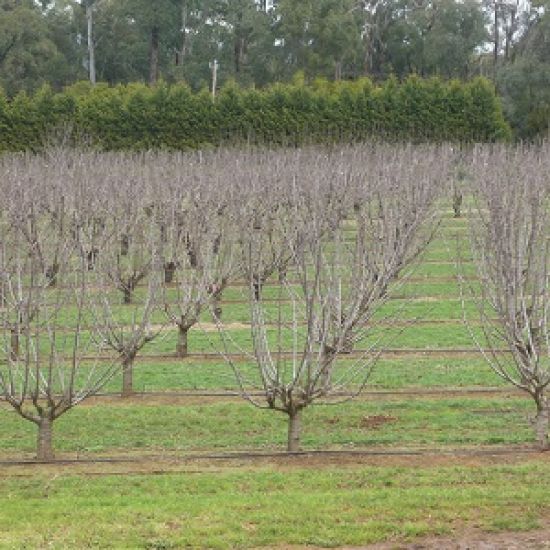 Dormant fruit trees (Photo courtesy Dr Rebecca Darbyshire, UoM)
Dormant fruit trees (Photo courtesy Dr Rebecca Darbyshire, UoM)
Temperate perennial fruit and nut trees annually enter a dormant phase over winter. This mechanism is an evolutionary advantage which protects trees from cold weather damage by preventing the growth of cold-sensitive shoots and flowers in response to a winter warm spell. For trees to resume growth in spring this dormant phase must be broken. Perennial fruit trees break dormancy after a prescribed 'sum' of winter conditions has passed. At this point, the tree has determined that winter has finished and will begin to flower in response to warm temperatures. This sum of cold weather to break dormancy is known as winter chill. The amount of winter chill required to break dormancy, the chill requirement, differs by fruit type and variety.
How does temperature influence winter chill?
Accumulation of winter chill to break dormancy is largely a temperature dependent process. The relationship of different temperatures and temperature regimes to dormancy breaking are varietal-specific but there are some general aspects:
- freezing temperatures do not contribute to dormancy breaking;
- there are optimum temperatures for the accumulation of winter chill;
- temperatures either side of the optimum decrease in ability to contribute to winter chill;
- high temperatures can undo previously accumulated chill; and
- cycling moderate temperatures with effective chilling temperatures enhances the accumulation of winter chill.
 Winter Chill in Australia
Winter Chill in Australia
Winter chill in Australia
See Range in Chill Portions for winter chill received in specific temperate fruit growing regions across Australia. (Note: this document does not meet WCAG 2.0 accessibility guidelines)
Want to calculate the chill at your orchard?
To calculate the chill at your orchard, utilise the - Chill portion calculator for Australian fruit trees .
Fruit tree orchards are particularly vulnerable to climate change, with changes likely to affect variables on which orchard productivity is reliant such as cold winter temperatures and extreme summer heat.
In order to better estimate winter chill, a tool has been developed by Rebecca Darbyshire (University of Melbourne) to assist growers assess chill conditions using their own logged data, but data can also be sourced from nearby Bureau of Meteorology sites or other weather stations.
Using the Dynamic chill model (Erez et al., 1990) to calculate chill portions, this tool is designed for season-by-season analysis and only data for one season should be processed using this approach.
More information about adaptation tipping points for Australian fruit trees can be found at the Primary Industries Climate Challenges Centre (PICCC).
Regional Chill Accumulation
Cumulative Chill Portions 2013 and 2014
See regional chill accumulation for
(Note: these PDF documents do not meet WCAG 2.0 accessibility guidelines)
Project details
Crossing the threshold: adaptation tipping points for Australian fruit trees

This project is supported by funding from the Department of Agriculture